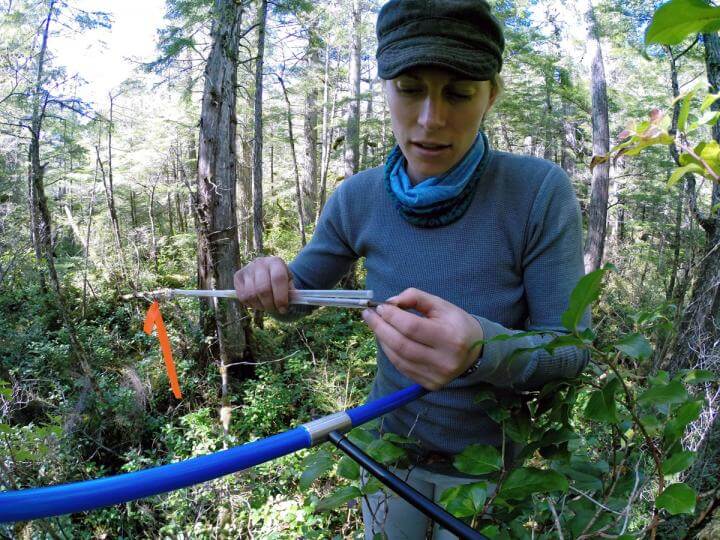Fire-scarred trees on isolated Hecate Island off British Columbia have helped researchers from two Pacific Northwest universities isolate patterns of wildfires over the past 700 years of climate data. Indigenous populations, they found, likely had a profound effect on fire activity.
The human connection became clear after determining that the last fire occurred in 1893, around the time the island was abandoned as indigenous populations were moved to permanent settlements on the mainland, said Daniel G. Gavin of the University of Oregon and Kira M. Hoffman of the University of Victoria.
“Fire is historically important in the West,” said Gavin, a professor of geography. “There is a lot of evidence from fire scars throughout the Pacific Northwest, not just in the dry pine forests, that point to more frequent fires having occurred before 1900.”
The study, published Oct. 26 in the open-access journal Royal Society Open Science, was the first to use tree-ring records obtained through fire-scarred trees spanning such long time scales in a temperate coastal rainforest. The island has a short dry season, experiences more than 4,000 millimeters (157 inches) of rain annually and is located in a northern region where both human- and lightning-caused fires have been considered to be rare.
The study helps to begin filling a void in the historical record about the frequency of fire activity in coastal temperate rainforests in the Pacific Northwest. The island also is in a place little affected by fire suppression or 20th century land uses, which makes attributing pre-20th century fire to human causes simpler than is possible in other places in the Pacific Northwest.
Hoffman, a former forest firefighter, chose the island for the study after finding a fire-damaged tree while she was there examining soils during a project for a master’s of science degree.
“Finding this fire evidence was an accident and I was really surprised because there had been no evidence of fire on the central coast of British Columbia,” she said. “The more I looked, the more I found. We know that the fires were smoldering ground fires because they didn’t kill the trees that they scarred, and they didn’t fully burn ground fuels.”
To help pursue her study, Hoffman spent four months in 2015 as a courtesy research associate with Gavin’s UO research group to learn a statistical analysis approach that Gavin had created for correlating wildfire occurrences with respect to other fires and past climate events. The technique was based on one developed by neuroscientists studying connections between firing neurons and movements elsewhere in the body. Gavin also had identified frequent fire patterns on Vancouver Island prior to the 1870s during his doctoral research at the University of Washington in Seattle.
The new study by Hoffman, Gavin and co-author Brian M. Starzomski, a professor in UVic’s School of Environmental Studies, drew data from some 3,000 trees and other vegetation at 30 plots within 300 hectares (741 acres) — an area that has three archaeological sites where indigenous populations had lived. In a 517-year period, from 1376 to 1893, 13 fire events occurring roughly every 39 years were documented. The fires tended to follow El Nino events by six to nine and 13 to 17 years.
The final fire, in 1893, was the largest and occurred during one of the wettest years on record and possibly coincided with undetermined events outside the regular cycle of fires. The farther away from the living areas, evidence for fires became scarcer.
The researchers reported that fire occurrences during their study period were 25 times more likely than previous estimates of greater than 1,000-year intervals, in which tree-ring records had not been used. Previous estimates were drawn mostly from air photos and charcoal buried in soils and preserved in lake sediments. They found little direct relationship between drought and fire years.
“It seems that fire events don’t have a pattern if you look only at weather in any given year,” Hoffman said. “When we pulled back and look at longer climate patterns, we began to see that fires were linked to prolonged periods of warm and dry conditions that build up over time.”
The team’s findings were in agreement with earlier research on the scarcity of fires in the region, but varied in that the researchers were able to tie fire events to human activity. The absence of fire after 1893, the researchers concluded, suggests that indigenous peoples had likely used fire as a tool for resource management.
“It’s possible they would have relied heavily on burning forests and single trees to create dry firewood for cooking and heating, clothing, canoes, food and many other resources,” Hoffman said.


